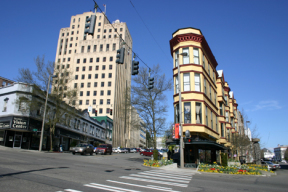A plan to designate the St. Helens neighborhood downtown as a Local Improvement District in order to coordinate repairs and upgrades to the areas infrastructure and surface streets has raised concerns among property owners and city leaders, according to a presentation Tuesday during the City Council study session.
At issue is whether the council should approve an ordinance creating the citys largest LID to fund $12 million in repairs and improvements to one of the oldest neighborhoods in Tacoma. If approved, the LID would provide for new sewer and water lines, sidewalk and street improvements, traffic-calming devices, and uniformed trees and streetlights.
We have struggled with the issue of all this decaying infrastructure, and the work not getting done in a coordinated manner, said Assistant City Manager Bill Pugh during the study session yesterday.
Indeed, in the St. Helens neighborhood, where much of the citys development boom has occurred, developers and city staffers have grappled with communicating and planning infrastructure improvements in time with new development projects, according to Tacoma Water manager Linda McRea.
A lot of the infrastructure is old, and would not support development in the area, said McRea.
Supporters argue that the plan — which calls for the citys utilities to pay for roughly 67 percent, or $8.5 million, and property owners to pay for 33 percent, or $3.5 million, over the course of 30 years — is more cost-effective for property owners. Typically, property owners pay 60 percent of an LID over a period of 20 years.
But property owners opposed to the LID say the city should listen to feedback from the neighborhood. According to surveys conducted by the city, a majority of the people who own approximately 250 parcels in the neighborhood oppose the LID. Last February, 53.8 percent of property owners opposed the LID, according to assistant public works director Craig Sively. A follow-up survey resulted in 51.3 percent opposition. Typically, the city will not approve an LID without support from the neighborhood, despite state law which permits an LID with less than 60 percent support.
Councilmember Rick Talbert underscored that point during yesterdays meeting.
Ultimately, the decision rests with us, said Talbert. State law has given us the responsibility if its in the best interest of the city. This is a way to respond to multiple tearing up of roads within our districts. State law allows us to form this LID in absence of majority support from property owners.
City Manager Eric Anderson reminded councilmembers that the city could decide not to approve the LID, and allow improvements to continue in a piecemeal fashion. But in a short period of time, you will have street in bad shape, said Anderson, a situation that might spur the neighborhood to support an LID. But funds for that LID would not come from city coffers, Anderson warned. Instead, it would come from property owners, probably at greater costs.
Part of the issue for me is the 50 percent majority rule, and shoving it down property ownerss throats if they dont want it, said Councilmember Jake Fey.
The bottom line for property owners is economics, said Councilmember Bill Evans, who showed support for the LID yesterday. A property owner has to be convinced it is to his or her advantage.
This would not benefit me at all, said Ann Marinkovich, a resident of the Bayview Condominiums on Broadway who spoke about the issue after the meeting. Marinkovich is concerned on a couple fronts: her LID fees would total $3,000, and one design for LID street improvements would eliminate a portion of parking at the end of her street.
But Dale Stirn, one of several residents of Skyview Terrace, favored the LID.
We want street lights and a more secure neighborhood, said Stirn, who spoke about the issue after yesterdays study session. Stirn reported his neighborhood has suffered from blight and burglaries recently, and work in the neighborhood would be welcomed. We want the improvements to bring our neighborhood up to what we think it could be.
Stirn argued that the 51.3 percent opposition was misleading because the city weighted the votes based upon development potential for given parcels. Property owners with undeveloped parcels would receive a higher LID assessment because of the potential benefit that infrastructure improvements would have toward the ability to sell their properties to developers. Therefore, said Stirn, their votes carry more weight.
It concerns me when they talk about a majority, said Stirn. There are only about eight or 10 property owners that represent the bulk of the opposition. It seems like the city is hung up on this very small number of people and calling them a majority. I find it hard to call those people a majority. Thats just patently false.
The City Council is expected to vote on the issue during its April 18 meeting.








